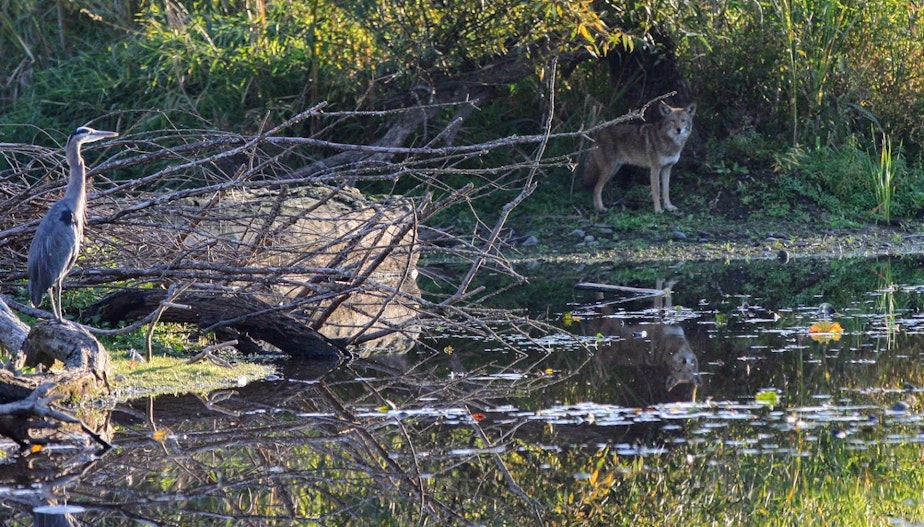Coyote sightings on the rise in Seattle

Two years ago in Laurelhurst, an upscale Seattle neighborhood, five coyotes played in the grass near a bus stop.
There was the mom coyote, the dad coyote and three pups.
And every morning, the Metro bus driver would pull up and chat with riders about these sweet bouncing pups.
But then they were gone.
And coming from their den in the grassy park surrounding a conference center was “a huge stain of blood,” a neighbor told KING 5 News.
Wildlife Services, a federal agency, confirmed they had killed three of the coyotes in a three-night stake-out. Someone had called the agency, they said in a statement, saying the coyotes had ventured too close to humans and neighborhood cats and dogs.
And so, the coyotes had to go.
Two years later, there are more coyote sightings than ever in Seattle, including in Laurelhurst where this coyote family group was killed.
Robert Long, senior conservation scientist at the Woodland Park Zoo, said these sightings may seem more numerous because of social media, but he said it’s also likely that coyotes are increasing in Seattle, as they are in cities nationwide.
Coyotes have roamed Seattle since the 1950s, Long said. “As wolves were eradicated in the early 1900s, coyotes started filling the space.”
Coyotes, native to the central area of the U.S., have shown they are smart and adaptable and may have a “genetic predisposition for colonizing new places and adapting to people,” Long said.
I called Long after reading about a coyote sighting on Nextdoor, a social media site where neighbors will post about missing packages, home break-ins and found chickens.
Hillary Miller, who has lived in Crown Hill since 1991, spotted a bushy-tailed canine from her upstairs window around 9:30 a.m. It appeared healthy, with a thick winter coat and its tongue hanging out.
“I was upstairs, looking out of one of the bedroom windows at the crows making noise," she said, "and I looked down and thought, ‘Why is someone’s dog off-leash and in the middle of the street?’”
When Miller realized this was not just any canine, she summoned her husband and daughter from downstairs. (The crows, meanwhile, dive-bombed the coyote.) Her daughter took this video:
Sponsored
Later that day, another neighbor posted a photo of what appeared to be the same coyote running up a busy road with rabbit parts dangling out its mouth.
Long said that he and two colleagues, Katie Remine of the Woodland Park Zoo and Mark Jordan of Seattle University, are launching the Seattle Urban Carnivore Project and will begin puting up cameras in parks and green spaces throughout the city in the next three weeks.
They will also set up the Carnivore Spotter website for Seattle-area residents to submit sightings of coyotes, bobcats and cougars. (We’ll include that link when it goes live.)
The aim of this project is to see where the animals live – not to kill them. Culling coyotes doesn’t work, Long said.
“Not too long ago, and in some places still, predators are considered bad things,” he said, “and sometimes federal or state agencies will kill or relocate them almost immediately.”
But anyway, kill one family, and another will move in within a year, Long said.
The researchers also hope to learn more about the animals — are they everywhere in Seattle, or in certain pockets?
(And do they truly mate for life and remain monogamous? After all, scientists hear about other animals that supposedly mate for life aren't so monogamous.)
The researchers will also examine coyote scat to see what they're eating, currently believed to be a diet of bunnies, rats and unsecured garbage, and they'll examine their DNA.
So ... what to do if you encounter a coyote on a city street? Haze it, Long said.
“Shine a bright light at them, shout at them,” Long said. Bang pots and pans. Don't let them get too comfortable with humans. And don't fret. It’s unusual for coyotes to bite people Long said – he hasn't heard of a case in Seattle.
Back in Laurelhurst there have been sightings of other coyotes. One roams the Center for Urban Horticulture, which is across the street from where members of the family group were killed, and some neighbors speculate, with both unease and delight, that he may be a surviving pup.




